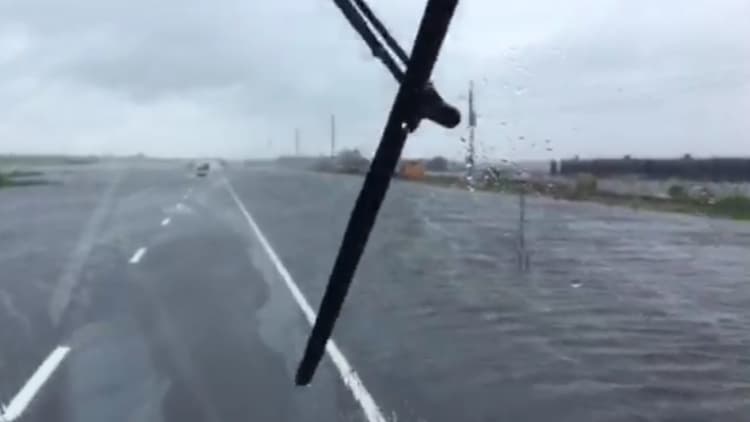Amid piles of wet drywall and ruined electrical systems, Houston businesses are inching back to normalcy.
Thousands of companies affected by Hurricane Harvey are tearing down walls and doors, installing dehumidifiers, shuffling work shifts, fortifying secure Internet connections for people who work remotely and pooling funds to help colleagues.
More from USA Today:
Irma, Harvey victims get help buying hot meals
Proposal would allow Harvey victims to use retirement savings for home repair
Lawmakers consider loosening 401(k) rules for storm victims
The recovery work is far from smooth and tasks such as negotiating with insurance companies, finding enough money for repairs and dealing with traumatized, no-place-to-go employees — will take weeks, if not months. Many small business owners without flood insurance, in particular, are possibly looking at years of debt and bankruptcies.

Still, the mood in Houston's business corridors, like the weather, has lifted, says Bob Eury, president of Central Houston, a non-profit group that plans business development in downtown Houston, which daily sees about 150,000 workers. "It'd appear that most employers in downtown are back up and operating," he said Thursday. "It feels like a normal day today. We're open for business. I want to make that clear."
The cycle of destruction-and-recovery will replay in much of Florida in the coming weeks as homes and businesses affected by Hurricane Irma also begin to dig out. While Texas and Florida differ in industries, they are among two of the nation's largest and most economically influential states. And the pace of their recovery could have significant consequences for the broader national economy.
Energy is Houston's primary economic engine, with many oil companies, refineries, pipeline operators and oil rig equipment makers based in the region. But it's also home to some of the world's most renowned hospitals and a thriving aerospace corridor, thanks to a sizable presence of the National Aeronautics and Space Administration. The gross domestic product of the Houston–The Woodlands–Sugar Land metropolitan area was $503.3 billion in 2015, the fourth largest of any metro area in the U.S., according to government data, so it's important to the nation that companies and people get back to work as quickly as possible.
After Harvey struck the region, roughly 27 percent of all leasable space in Houston, including apartments, could be flooded, or about 600 million square feet, estimated CoStar Group, a commercial real estate information firm. About 70 million of it was office buildings, including low-rise structures.
Damage from Harvey would likely reach $150 billion to $200 billion, estimated Moody's Analytics.
Buffalo Bayou, the slow-moving river that stretches through downtown overflowed after days of rain, flooding the theater district and other parts of downtown.

Just two blocks from the Bayou, Alley Theatre, an award-winning indoor theatre in downtown, was still digging out from eight feet of water that ruined its basement stage, Neuhaus Theatre The smaller of Alley's two stages, Neuhaus seats 310 and features a variety of plays and musicals, such as Broadway hit "Hand to God" and David Sedaris' "The Santaland Diaries."
Water — or more accurately, a black mixture of chemicals, sewage and water — has been pumped out, having left about $15 million of damage. But also destroyed in the basement are five dressing rooms and most of its 100,000 props that were collected over 70 years, says Dean Gladden, managing director of Alley Theatre.
"I was thinking how the hell am I going to get the water out of here," Gladden said recounting his first time seeing the damage in person. He was stuck at home with his block flooded and saw the theater damage at first on a Facebook post by colleagues. "(When I saw it on Facebook), I said 'oh, we may have serious problems.'… I couldn't get out. My entire street was flooded."
When he finally visited the damaged stage in person the next day, he knew he had to scramble for remediation companies to dry it out, examine air quality and remove mold. But remediation providers were heavily in demand, and he found one through his office building's property manager. "It was my first call," he said.
Two blocks northeast, Houston Ballet was dealing with its own remediation problems. Two of its dance studios were submerged with three inches of water. And three different crews weaved through the facility to remove sheet rock and the thick flooring made especially for jumping dancers, as well as replacing costly water pumps and electrical systems.
About seven miles south of the ballet company, crews at MD Anderson Anderson Cancer Center, whose main lobby was drenched, deployed dehumidifiers throughout its campus, removed wet drywall and are using infrared cameras to identify unseen wet spots, says Matt Berkheiser, its executive director of environmental health and safety.
Meanwhile, some big store operators returned to piles of wet merchandise. A Target store in Humble, Texas, located 19 miles north of downtown, is still closed after it was submerged in six and a half feet of water. Another Target store in South Houston, which had a half foot of water, also remains closed.
The retail giant is in the midst of dumping equipment and damaged merchandise to salvage companies. "If (merchandise) is not up to 100 percent of our standards, we will not sell (it)," says John Sheehan, senior group vice president of stores in the Houston area for Target.

But experience with past storms may have mitigated damage for some large companies in the area. After Hurricane Ike ruined the University of Texas Medical Branch at Galveston with 20 inches of rain in 2008, the academic health center moved key equipment and generators to higher floors, says Jason Botkin, an environmental services manager of Sodexo, which handles facilities management at UTMB. It also deployed a "ride-out" team of 68 employees who worked in rotations throughout the storm to serve the 300 patients on site. With little physical damage, the hospital stayed open. "We were prepared this time," he said.
Companies are also contending with displaced workers. HCA, a for-profit hospital chain with 15 hospitals in the Houston area, estimates 10 percent of its nurses have "significant" damage at home. And it fired up its company jet and hired private charters to fly in 300 nurses from other parts of the country to make up for the Houston-based nurses who aren't able to make it to work.
About 18 percent of the employees at Memorial Hermann, one of the largest not-for-profit healthcare system in Texas, have lost homes or damaged property. And it's providing hotels and advancing checks for them and shuffling work shifts to continue operations.
With many workers still unable to come to work and expecting a jump in demand for its products, Home Depot -plans to hire more workers in the coming weeks.
Large employers are also tapping their employee-help funds. HCA has given over $1 million in grants -- up to $7,500 per affected employee -- that can be used for home repair, hotel, food and other expenses. Home Depot has distributed about $980,000 in similar funds.
Finding new venues for scheduled business commitments and continuing business also sits high on companies' to-do lists. Alley Theatre's premier of "Describe the Night," a play about a Russian spy written by playwright Rajiv Joseph, was scheduled for next week at the ruined Neuhaus stage. The play's entire set was also destroyed.
Alley's Gladden found a partner in the University of Houston, which agreed to host it at its 185-seat Quintero Theatre. "It's better than nothing," he says. "In 24 hours, we redesigned the set."
The show will go on, as originally scheduled, on Sept. 15.
Like this story? Like CNBC Make It on Facebook.


